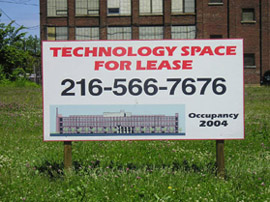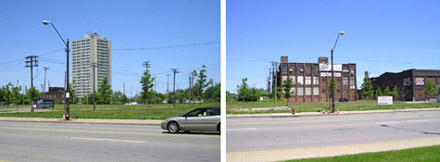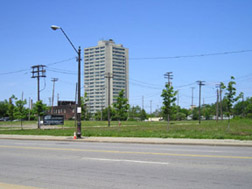


| Vol. 1, Issue 4 | |

|
By Marc Lefkowitz
Once the “Grand Avenue” that boasted the world’s wealthiest addresses and a bustling commercial district, Euclid Avenue today is suffering. If you’re in search of a 'quiet crisis,' drive or walk from Public Square to Midtown and take notice of all the dark storefronts. Euclid Avenue connects the central business district, the east side and the cultural hub at University Circle. After the promise of a new lakefront and a revitalized Cuyahoga Valley, Euclid Avenue is Cleveland’s third frontier. But despite plans that include installing bike lanes and sidewalk dining, the $200 million Euclid Corridor Transportation Project has been a lead balloon. Letters to the editors in newspapers around town blast it as another example of government run amok (even as most incorrectly assume that the federal dollars could be transferred to fixing their street). Midtown, particularly the section between E. 55th and E. 70th on Euclid Avenue, hasn’t had much to cheer about since 1995 when Pierre’s Ice Cream relocated and expanded its operations at E. 65th and Euclid. All around, the building shells of the city’s light manufacturing center and the neighborhood that supported it are crumbling. Like it or not, all is about to change. The Greater Cleveland Regional Transit Authority (RTA) is preparing to spend the first $60 million of the $200 million for the Euclid Corridor project on a new streetscape and the city’s first dedicated bus lanes (running state-of-the-art diesel-electric hybrid buses) on Euclid. Plans are also underway for a $21 million Midtown Technology Center at E. 59th and Euclid from local developer John Ferchill, who was recently in the news for the adaptive reuse of the former, sprawling Pabst Brewing Company complex in Milwaukee. Even as the individual pieces begin to fall into place, the larger vision for Midtown is far from set. So Hotel Bruce went in search of the future Midtown—we asked top local practitioners in urban design, architecture and development to consider whether the proposals to remake Midtown into a hotbed of biotech research will help recapture its urbanity and spur more development? A place to begin is with the linkages, or what’s
in proximity to Midtown, says David O’Neill, a partner at
real estate brokerage firm Colliers International.
O’Neill, who is not involved in development in Midtown, points to Beacon Place and Church Square as an example of a successful, infill mixed-use development linked to the Clinic. He thinks it’s replicable in Midtown, and suggests that a developer build residential spaces at $85-100/sq. ft. and sell them at around $115-120/sq. ft. “A lot of what’s coming downtown is selling at $200 a square foot,” he says. “If you take advantage of forgivable second mortgages and the New Market Tax Credits, ultimately, that’s the type of situation that fills gaps and makes new development more affordable.” On his wish list for Midtown is a development that serves both the biotech nerds and nearby residents. And perhaps its design could be a little more ‘creative’ and walkable than Beacon Place and Church Square. “I would like to see affordable, for-sale housing as part of a retail and biotech mixed-use development,” O’Neill says. “You’ll want neighborhood retail—a coffee shop, family style dining, basic services like banking, dry cleaning, postal, and food operations.“ “If you plan it, you can have cool spaces that relate to the creative class and neighborhood buying power. Rite Aid and the like…I mean, it’s kind of suburban. The limited retail around the Clinic is not serving the shopping needs of a daytime trade.” Creating a vibrant, walkable district will happen if it’s the collective value of the community and not seen as too risky by the private market, notes Andrew Baque. Baque is an urban designer, formerly at the Cleveland Urban Design Collaborative, now at Wade-Trim. “For people who choose a compact environment,
the notion of efficiency and access is critical,” he says.
"They choose to live in a place where forms of entertainment
and conveniences that feed our daily lives are not far away. Those
principles can’t be sacrificed if you’re doing biotech
or another institutional development. The guarantee of success lies
in diversity of use.” Urban redevelopment often takes into account that a fairly high percentage of people walk to shop, says O’Neill. Still, New Urbanism—close-knit development with ground-level retail, commercial/residential above and parking in the back—is a fairly new concept for Cleveland. Is the market ready or is new urbanism a notion that continues to get lip service? The Cleveland Clinic’s monolithic designs as well as the sketches for the proposed Midtown Technology Center—a modernist glass and steel box dropped down in the center of the parcel of land between Euclid and Chester – may provide some clues. Receding from the street and scaled like a HumVee, the Clinic’s buildings set the standard on Euclid. They are uninviting because they turn their back to the community, says local architect Calvin Singleton Jr. who serves as co-chair of the Euclid Corridor Subcommittee of the Arts and Transit Committee. Yet Singleton hastens to add that classic 1920’s architecture may not be the answer for a future Midtown, either.
“A lot of times, a culture came into a community and tried to meld into a building not always suited to it,” he says. “I don’t know if preserving buildings is the best way to pay tribute. I would start by thinking, ‘how do I interact with the community to make it fuller’ instead of an entity plopped in there.” One way to do that is by paying homage to Cleveland as a hub of attractions—be it art, music, culture, or sports, Singleton says. He points out the history of the area which includes the Cleveland Arena and boxing impresario Don King; Leo’s Casino, a local club that hosted the hottest acts from Motown; the Italian stonemasons who left their mark on the architecture; the large African-American population, and even the small, relatively unknown Japanese-American population that migrated there after World War II. The remnants of the past—the empty warehouses in Midtown—represent both the social character and the opportunity of the area, says Baque. He mentions the abandoned warehouses in the Warehouse District, which were adapted into residential and commercial spaces by artists and creatives in the 1980s. “Warehouses allow for a range of tenant types and users of a district,” says Baque. “They tend to be flexible building types. If you have ‘missing teeth’ that could be good because it provides an opportunity for new construction. And you’re not relying on one large investor with deep pockets.” Filling in the ‘missing teeth’ or gaps from abandoned parcels in urban areas with retail and housing has been the rallying cry of the Campbell Administration, which recently inked a deal to convert the former LTV West side mill into Steel Yard Commons, a retail power center. Yet, O’Neill, who was with Campbell on her recent trip to Las Vegas to court big box retailers, disagrees with a conclusion from the recent Cleveland retail study (completed by Oster Research Group) that E. 55th and Euclid is a potential spot for big box. “The Oster study did a good job identifying the potential for retail in the city, but you have a demographic hole to the north with the lake at the periphery,” O’Neill says. “I’m not opposed to seeing big boxes coming into the city. They do a superior job of delivering products. Americans want it better, faster, and cheaper and by God they got it… “The mayor speaks eloquently about the [estimated $1.3 billion in retail sales] leakage from the city. It’s time to reach out and capture these retailers. [Midtown] is a viable stretch—it’s just not on the radar screen because it has not been developed yet.” With massive public investment about to be poured into a new infrastructure on and below Euclid Avenue, it is only a matter of time before the private market lines up to vie for development rights. The discussion of land-use, design, and building types will then begin in earnest. “You recreate a community with place-making
real estate,” says O’Neill, who sold the multimillion-dollar
adaptive reuse of the Bradley Building in the Warehouse District
as live-work lofts. “Despite the fact that it’s tough
to assemble sites and combine density with mixed uses, your space
breeds creative ventures.”
|
|
What's Feature Well? What would the city look like if the new guard were in charge? Each issue focuses on an area in the city that could benefit from some creative energy with feature articles that offer a vision for a new Cleveland, Q&As with the movers-and-shakers who are making a difference, and visual evidence of how the landscape might look if creatives were calling the shots. |
![]() Also in this issue's Feature Well...
Also in this issue's Feature Well...
Two urban planners—one a writer, the other an artist—create a conceptual plan for Midtown Euclid with deep roots to the past
Once Upon a Rustbelt | Party Center | Raw Materials | Subscribe | Urban Underpants


